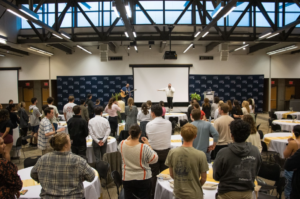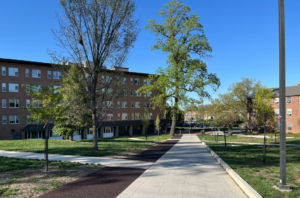Trey Trahan Discusses Peace Architecture: Designing for Healing and Connection

Image Courtesy of Trahan Architects
By Kat Kaderabek
A speaker driven by compassion. An audience rapt with attention. A message the architecture school so desperately needed to hear. Trey Trahan’s presentation about Peace Architecture on Monday, September 20th was nothing short of phenomenal. The event started with Catholic University professor Julio Bermudez’s announcement that the presentation would not be recorded nor broadcasted via Zoom: shocking in the Zoom age.
“We are living for right now,” Bermudez instructed the room. “Either you show up [here] and do your business or get out of the way. This is a commitment to life. We profess architecture together.”
With that notion in mind, he introduced the 13th Walton Critic of the Walton Critic Lecture Series, hosted annually by the Architecture School. Trey Trahan is the founder of a global architecture firm, Trahan Architects, grounded in the principles of mindful-human architecture design.
But what does that mean? Trahan went on to talk about “rootedness.” He cares deeply about authenticating his work. He has a desire of his own to produce buildings “that possess an atmosphere, character, expression, and attitude of empathy.”
Peace Architecture, he noted, “is about humility and bringing dignity to others’ lives.” Peace Architecture can truly be understood by asking, “what is unique or embedded in a place that we can learn from? That tells us about his history, evolution, etcetera.”
Trahan noted that the first step to architecture that brings peace and equity is understanding the watershed. How the watershed informs the flora, fauna, unique solis, and the depth of the topsoil is crucial in crafting architecture that connects to place.
Trahan Architects connects to several places; some they even buy. Around 50% of company profits are invested annually in property. The first year of Trahan’s attempt into equitable measures resulted in the purchasing of 600 acres of land in Patagonia, Chile. This almost entirely untouched landscape provided the basis for a hired team of ecologists and landscape architects to study the mountains, rivers, and wildlands of the area.
This prime piece of property would soon be worth a significant amount of money. But Trahan surprised the crowd of architecture students when he revealed that his firm left the land entirely untouched. In terms of equitable architecture, he noted the environmental responsibility he had to “mute our egos and choose not to build here.”
The only noteworthy addition to the area that the firm touched was turning several fallen trees into a 260 foot pier that overlooked the luscious landscape .
Trahan explained that it is the architect’s job not only to create space for common ground, but to “find the space within ourselves to engage with others that disagree with us.” One of his upcoming projects intends to do just that.
This upcoming project is located in Trahan’s home state of Louisiana and involves the rich history of black people, who suffered so greatly under some of the cruelest plantation owners in history.
“Justice has to be directed to the descendants,” Trahan explained. “What does justice mean to them? We get caught up in reparations; people think it is a limited way. Reparations can mean many things. It’s more than the space we think of, it’s about rights, resources, and opportunity.”
Trahan concluded his presentation by noting that most people take ownership for granted. However, the Black community in Louisiana has a low ownership rate that needs to be changed. Is there a permanent and far-reaching solution? Trahan admitted that he does not have the answer.
“But we are investing in it,” he said. “I care deeply for learning the answer.”
Trahan’s words left the crowd with a sense of righteousness and empowerment. His design philosophy is one that will bring about a more equitable society that shares resources, protects the planet, and gives back to those who have been oppressed.
With the last slide concluding, Trahan left the Architecture School with these words to ponder: “Just because you can, doesn’t mean you should.”








